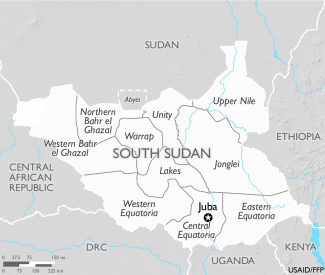March 30, 2020
After more than six years of conflict, South Sudan remains one of the most food-insecure countries in the world. Ongoing violence, flooding, resultant population displacement, and disrupted trade, markets, and cultivation activities have exacerbated food insecurity and humanitarian needs.
Situation
- An estimated 6 million people—representing approximately 51 percent of South Sudan’s total population of 11.7 million—may face Crisis (IPC 3) or worse levels of acute food insecurity and require urgent food assistance between February and April, according to the most recent IPC analysis.* A projected 6.5 million people will likely face similar levels of acute food insecurity at the peak of the lean season from May to June—the period when food is most scarce—representing a slight improvement compared to the estimated 6.9 million people in similar levels of acute food insecurity during the 2019 lean season.
- Many vulnerable families in South Sudan continue to depend on food assistance to meet their basic needs. Key drivers of the high levels of acute food insecurity in the country include the negative effects of flooding and violence on livelihood activities, poor macroeconomic conditions, cereal production shortages, below-average access to livestock products, and elevated food prices, the Famine Early Warning Systems Network (FEWS NET) reports. FEWS NET warns that a risk of Famine (IPC 5) remains in South Sudan if a rise in conflict prevents people from moving to look for food or prevents relief actors from delivering food assistance for a prolonged period. Households who did not harvest or do not own livestock are also at risk of Famine, according to FEWS NET.
- The UN Office for the Coordination of Humanitarian Affairs (OCHA) reports that a swarm of mature desert locusts arrived from Uganda to Ikotos and Magwi counties in Eastern Equitoria in February, posing a risk to croplands and threatening to exacerbate the country’s food security crisis.
- Acute malnutrition remains a significant problem in South Sudan. In 2020, approximately 2 million people in the country will require nutrition assistance, including 290,000 children facing severe acute malnutrition, 1 million children facing moderate acute malnutrition , and 470,000 malnourished pregnant and lactating women, according to South Sudan’s 2020 Humanitarian Needs Overview.
* The Integrated Food Security Phase Classification (IPC) is a standardized tool that aims to classify the severity and magnitude of acute food insecurity. The IPC scale, which is comparable across countries, ranges from Minimal (IPC 1) to Famine (IPC 5).
[[nid:266391]]
Response
- Since the start of the conflict in South Sudan, USAID’s Office of Food for Peace (FFP) and its partners—including the UN World Food Program (WFP) and the UN Children’s Fund (UNICEF)—have assisted the most vulnerable and conflict-affected populations through emergency food and nutrition interventions across the country.
- FFP also partners with Catholic Relief Services to provide emergency food assistance, access to safe drinking water, and livelihoods support in Jonglei State, as well as with FAO to support households with food vouchers and the distribution of seeds, planting tools, and fishing kits for increased food production.
Food for Peace Contributions
Total Contributions:
| U.S. Dollars | Metric Tons | |
|---|---|---|
| Fiscal Year 2020 | $245.2 million | 124,377 MT |
| Fiscal Year 2019 | $374.8 million | 168,384 MT |
| Fiscal Year 2018 | $398.2 million | 154,341 MT |
* Metric tonnage does not reflect funding for vouchers or cash transfers.
Related Resources

